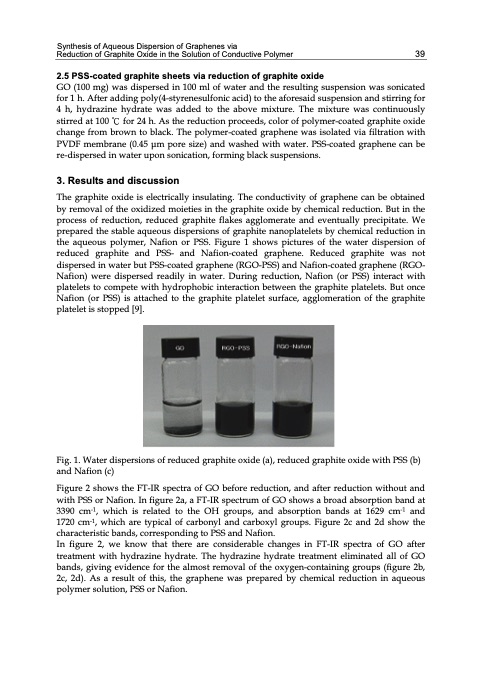
PDF Publication Title:
Text from PDF Page: 049
Synthesis of Aqueous Dispersion of Graphenes via Reduction of Graphite Oxide in the Solution of Conductive Polymer 39 2.5 PSS-coated graphite sheets via reduction of graphite oxide GO (100 mg) was dispersed in 100 ml of water and the resulting suspension was sonicated for 1 h. After adding poly(4-styrenesulfonic acid) to the aforesaid suspension and stirring for 4 h, hydrazine hydrate was added to the above mixture. The mixture was continuously stirred at 100 °C for 24 h. As the reduction proceeds, color of polymer-coated graphite oxide change from brown to black. The polymer-coated graphene was isolated via filtration with PVDF membrane (0.45 μm pore size) and washed with water. PSS-coated graphene can be re-dispersed in water upon sonication, forming black suspensions. 3. Results and discussion The graphite oxide is electrically insulating. The conductivity of graphene can be obtained by removal of the oxidized moieties in the graphite oxide by chemical reduction. But in the process of reduction, reduced graphite flakes agglomerate and eventually precipitate. We prepared the stable aqueous dispersions of graphite nanoplatelets by chemical reduction in the aqueous polymer, Nafion or PSS. Figure 1 shows pictures of the water dispersion of reduced graphite and PSS- and Nafion-coated graphene. Reduced graphite was not dispersed in water but PSS-coated graphene (RGO-PSS) and Nafion-coated graphene (RGO- Nafion) were dispersed readily in water. During reduction, Nafion (or PSS) interact with platelets to compete with hydrophobic interaction between the graphite platelets. But once Nafion (or PSS) is attached to the graphite platelet surface, agglomeration of the graphite platelet is stopped [9]. Fig. 1. Water dispersions of reduced graphite oxide (a), reduced graphite oxide with PSS (b) and Nafion (c) Figure 2 shows the FT-IR spectra of GO before reduction, and after reduction without and with PSS or Nafion. In figure 2a, a FT-IR spectrum of GO shows a broad absorption band at 3390 cm-1, which is related to the OH groups, and absorption bands at 1629 cm-1 and 1720 cm-1, which are typical of carbonyl and carboxyl groups. Figure 2c and 2d show the characteristic bands, corresponding to PSS and Nafion. In figure 2, we know that there are considerable changes in FT-IR spectra of GO after treatment with hydrazine hydrate. The hydrazine hydrate treatment eliminated all of GO bands, giving evidence for the almost removal of the oxygen-containing groups (figure 2b, 2c, 2d). As a result of this, the graphene was prepared by chemical reduction in aqueous polymer solution, PSS or Nafion.PDF Image | GRAPHENE SYNTHESIS CHARACTERIZATION PROPERTIES

PDF Search Title:
GRAPHENE SYNTHESIS CHARACTERIZATION PROPERTIESOriginal File Name Searched:
Graphene-Synthesis.pdfDIY PDF Search: Google It | Yahoo | Bing
Salgenx Redox Flow Battery Technology: Power up your energy storage game with Salgenx Salt Water Battery. With its advanced technology, the flow battery provides reliable, scalable, and sustainable energy storage for utility-scale projects. Upgrade to a Salgenx flow battery today and take control of your energy future.
| CONTACT TEL: 608-238-6001 Email: greg@infinityturbine.com | RSS | AMP |